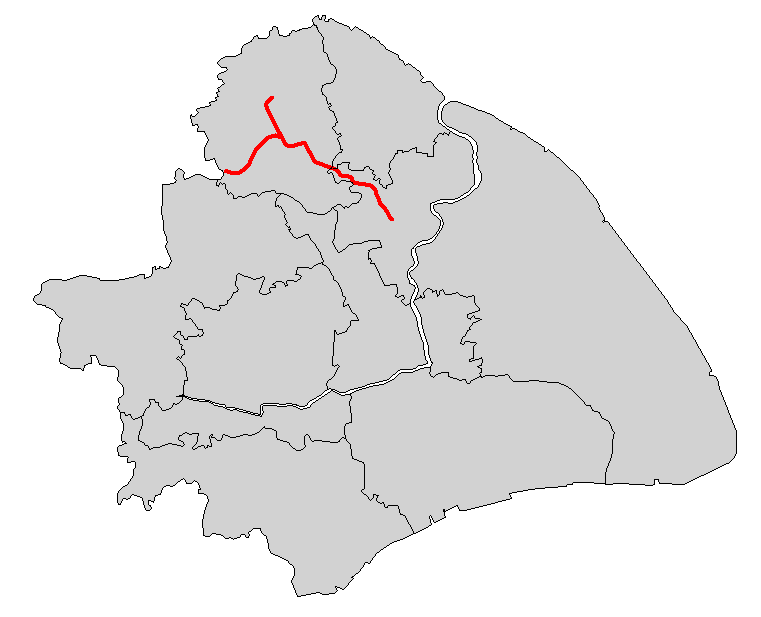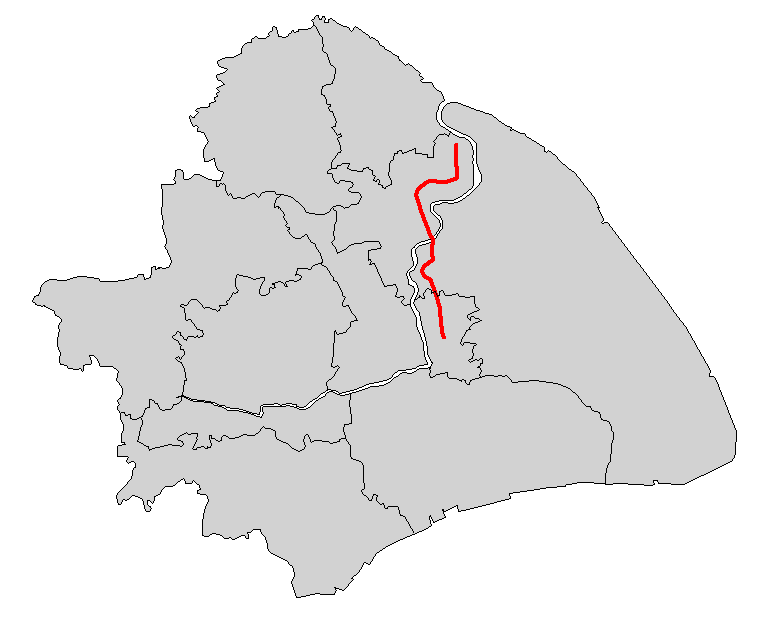|
Line 6, Shanghai Metro
Line 6 is an eastern north–south line of the Shanghai Metro network. It opened on December 29, 2007. The entire line is located in the Pudong New Area. A complete trip between the two end terminals, and takes approximately 1 hour and 10 minutes. Line 6 has been dubbed the unofficial nickname “Hello Kitty Line” due to its lurid pink livery. The line is colored on system maps. History Controversy Like the Lexington Avenue Subway in New York City, passenger traffic has consistently exceeded the designed capacity of the line since its opening and causes severe strain to the services. The planning of Line 6 began in 2000, but real estate development along the proposed line happened faster than anticipated upon the line's initial opening. Uniquely at the time, a majority of the Line 6 opened in one phase creating a 30 kilometer long corridor overnight. Existing buses were cancelled or diverted simultaneously due to the opening of Line 6, forcing residents along the line to trav ... [...More Info...] [...Related Items...] OR: [Wikipedia] [Google] [Baidu] |
North Waigaoqiao Free Trade Zone Station
North Waigaoqiao Free Trade Zone () is a station on Line 6 of the Shanghai Metro. It began operation on December 29, 2007. The station is located along North Yanggao Road within the Waigaoqiao Free Trade Zone, Pudong Pudong is a district of Shanghai located east of the Huangpu, the river which flows through central Shanghai. The name ''Pudong'' was originally applied to the Huangpu's east bank, directly across from the west bank or Puxi, the historic city .... Around the station * Waigaoqiao Power Station References Shanghai Metro stations in Pudong Line 6, Shanghai Metro Railway stations in China opened in 2007 {{Shanghai-metro-stub ... [...More Info...] [...Related Items...] OR: [Wikipedia] [Google] [Baidu] |
Island Platform
An island platform (also center platform, centre platform) is a station layout arrangement where a single platform is positioned between two tracks within a railway station, tram stop or transitway interchange. Island platforms are popular on twin-track routes due to pragmatic and cost reasons. They are also useful within larger stations where local and express services for the same direction of travel can be provided from opposite sides of the same platform thereby simplifying transfers between the two tracks. An alternative arrangement is to position side platforms on either side of the tracks. The historical use of island platforms depends greatly upon the location. In the United Kingdom the use of island platforms is relatively common when the railway line is in a cutting or raised on an embankment, as this makes it easier to provide access to the platform without walking across the tracks. Advantages and tradeoffs Island platforms are necessary for any station with m ... [...More Info...] [...Related Items...] OR: [Wikipedia] [Google] [Baidu] |
Line 11 (Shanghai Metro)
Line 11 is a northwest–southeast line of the Shanghai Metro network. Since October 2013 Line 11 serves Kunshan city, making it is the second intercity metro in China after the Guangfo Metro and the first that crosses a provincial boundary. With a single-line mileage of 82.386 kilometers, is the longest single-line subway line in China. The line is colored on system maps. History The line 11 was originally planned to be from Jiading to Nanhui New City, with a total length of 120 kilometers, the south part of the line has been transferred to line 16. The 1st phase of line 11, which runs from to , opened on 31 December 2009. A branch line from opened on 29 March 2010. The 2nd phase runs from Jiangsu Road to . It opened on 31 August 2013. The 3rd phase connects Luoshan Road and the . This section is long with 3 stations. All new stations except for the Disney Resort station opened on December 19, 2015. The Disney Resort started to trial operation on April 26, 2016. From J ... [...More Info...] [...Related Items...] OR: [Wikipedia] [Google] [Baidu] |
Line 8 (Shanghai Metro)
Line 8 is a north-south line of the Shanghai Metro network. It runs from , in Yangpu District to , in Minhang. The line is colored on system maps. History The subway line's first phase began trial operation on September 17, 2007 and officially opened on December 29, 2007, running between and . The second phase, from Yaohua Road to began operation on July 5, 2009. Two stations opened later than the rest of the line: in September 2012 and opened in April 2011. On May 4, 2017 it was announced the third phase had been renamed the Pujiang line, and will be a new long automated people mover line running from Shendu Highway station to Huizhen Road station. It will use rubber tire Bombardier Innovia APM 300 technology. On January 13 Bombardier delivered the first out of 44 autonomous people movers to Shanghai. It opened on March 31, 2018. Controversy Even though Line 8 is a heavy rail rapid transit line, "Type C" trains designed for light metro lines consisting of 6 or 7 ... [...More Info...] [...Related Items...] OR: [Wikipedia] [Google] [Baidu] |
Line 7 (Shanghai Metro)
Line 7 is a northwest–southeast line of the Shanghai Metro network. It connects the Baoshan District of Shanghai with the downtown core as well as the Pudong New Area and the Expo 2010 site. It currently runs from in Baoshan District to in Pudong, which is near Shanghai New International Expo Center. serves as a terminus for trains returning to Chentai Road depot. The line is colored on system maps. History * Construction began on November 24, 2005. * The first section of the line from Huamu Road to Shanghai University opened to the public on December 5, 2009. **In the first few months of operation, the trains only operated from 9AM-4PM to allow for extended testing of the line. **On February 20, 2010, operating hours have been extended to fall in line with the rest of the metro system afterwards.http://www.shanghaidaily.com/sp/article/2009/200912/20091203/article_421482.htm *On April 20, 2010, Houtan station entered operation. *In December 2010, three stations on the nor ... [...More Info...] [...Related Items...] OR: [Wikipedia] [Google] [Baidu] |
Line 9 (Shanghai Metro)
Line 9 is a southwest-northeast line of the Shanghai Metro network. The line runs from in Songjiang District to in Pudong. The line is colored on system maps. History In the initial planning of Line 9, the entire line was from Fengjing to Chongming Island. Later, the plan to extend to Fengjing was cancelled, and the section to Chongming Island was changed to Chongming line. The first phase of Line 9, from to stations, opened on December 29, 2007. It uses the Bombardier Movia trains which were lended to line 1. Line 9 did not directly connect to the rest of the Shanghai Metro network until the opening of the Line 9 portion of the station on December 28, 2008. The station is an interchange between lines 3 and 4. A shuttle bus conveyed passengers between Guilin Road and Yishan Road stations until construction was completed. In December 2009, the second phase of line 9 (from to ) was completed, providing passengers with a direct link from Songjiang District in the we ... [...More Info...] [...Related Items...] OR: [Wikipedia] [Google] [Baidu] |
Line 2 (Shanghai Metro)
Line 2 is an east–west line in the Shanghai Metro network. With a length of nearly , it is the second longest line in the metro system after line 11. Line 2 runs from in the west to in the east, passing Hongqiao Airport, the Huangpu river, and the Lujiazui Financial District in Pudong. With a daily ridership of almost 1.5 million, it is the Shanghai Metro's busiest metro line. The eastern portion of the line, from to Pudong International Airport, was once operated almost independently from the main segment until April 18, 2019, while through service between these two started the next day. The line is colored on system maps. History The first section of line 2 was opened on October 28, 1999, from to . This section, which included 12 stations, totaled . A year later, was added to the eastern part of the line, adding . Four new stations, located west of the Zhongshan Park station, opened in December 2006, extending the line to . This section added to the line. Four years l ... [...More Info...] [...Related Items...] OR: [Wikipedia] [Google] [Baidu] |
Century Avenue Station
Century Avenue () is a major Shanghai Metro interchange station named after Century Avenue Century Avenue () is a major street in Pudong, Shanghai. It begins near the Oriental Pearl Tower and ends at Yanggao Road, in a pedestrianised section leading to Century Park. Major Landmarks There are many major landmarks along the road (fro ..., which runs above the station. It is currently one of two stations (the other one being Longyang Road station) on the Shanghai Metro network to serve four lines (namely Lines 2, 4, 6 and 9), and the first four-line interchange metro or subway station in mainland China. This station, first known as Dongfang Road station (), is part of the initial section of Line 2 that opened from to that opene ... [...More Info...] [...Related Items...] OR: [Wikipedia] [Google] [Baidu] |
Sohu
Sohu, Inc. () is a Chinese Internet company headquartered in the Sohu Internet Plaza in Haidian District, Beijing. Sohu and its subsidiaries offer advertising, a search engine (Sogou.com), on-line multiplayer gaming (ChangYou.com) and other services. History Sohu was founded as Internet Technologies China (ITC) in 1996 by Charles Zhang after he completed his PhD from the Massachusetts Institute of Technology and received venture capital funding from colleagues he met there. The following year, Zhang changed the name of ITC to Sohoo in homage to Yahoo! after meeting its cofounder, Jerry Yang; the name was soon after changed to Sohu to differentiate it from the American company. Sohu has been listed on NASDAQ since 2000 through a variable interest entity (VIE) based in Delaware. Sohu's Sogou.com search engine was in talks to be sold in July 2013 to Qihoo for around $1.4 billion. On September 17, 2013, it was announced that Tencent has invested $448 million for a minority ... [...More Info...] [...Related Items...] OR: [Wikipedia] [Google] [Baidu] |







.jpg)